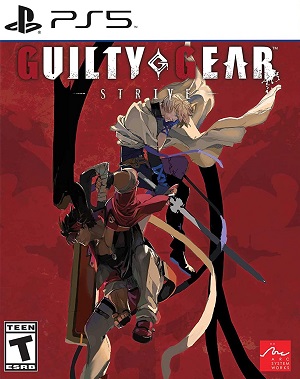
It seems crazy to say it now, but there was a time when the next Guilty Gear wasn’t inevitable. After Arc Sys lost the rights to Sammy, and later Sega Sammy, it seemed like we’d never see another entry in one of the most important fighting game series ever made. By the time BlazBlue, Guilty Gear’s spiritual successor, hit the scene in 2008, it seemed like Guilty Gear was well and truly dead. Then Arc Sys bought the rights back from Sega Sammy and announced Guilty Gear Xrd Sign. When I watched Sign’s announcement trailer for the first time, I genuinely couldn’t believe it. I watched it over and over again in a state of sheer joy, trying to convince myself it was a joke. It wasn’t. For the first time in a decade, we were getting a completely new Guilty Gear game. No, Guilty Gear 2 doesn’t count.
I played Sign and its follow-ups, Revelator and Rev 2, for several hundred hours, grinding out combos in training mode, completing the game’s hundreds of missions, and facing off in thousands of matches. I’m not a pro Guilty Gear player by any means, but I am pretty good and have played every game in the series. I tell you this so you know how I approached Strive. With Xrd, I was fully on board. While I was excited for Strive, I was also apprehensive. I knew it meant big changes for the series on a mechanical level. After dozens of hours in the game across several betas and the final build, I can officially say that Strive is a success – at least mostly.

"Arc Sys has billed Strive as the conclusion to Sol Badguy’s story and Strive doesn’t disappoint. The story mode wraps up most of the main cast’s arcs, and it does it well."
Strive picks up approximately after Rev 2 leaves off, continuing the adventures of Sol Baduy, Ky Kiske, I-no, and friends as they recover from the events of Rev 2’s finale and Sol prepares for his final showdown with the series’ antagonist, That Man, aka The Gearmaker, aka Asuka R. Kreutz. Arc Sys has billed Strive as the conclusion to Sol Badguy’s story and Strive doesn’t disappoint. The story mode wraps up most of the main cast’s arcs, and it does it well. While there are still places Guilty Gear’s story mode could go, Strive’s story, at least as it stands now, feels like an ending the series has been building to since the original game was released in 1998.
As satisfying as it is for series veterans, however, it also might be hard to follow if this is your first Guilty Gear game. To its credit, Strive does its best to explain things. The game offers an in-depth character relationship chart that details each character and how they relate to one another during the events of past Guilty Gear games and the series overall backstory. There’s also a detailed glossary explaining everything from character backstories to the series timeline, exactly what a gear is, why there’s a guilty one, and the way Guilty Gear’s world works. It’s extremely detailed, but it’s also a lot to take in, so you’re probably best served by checking out the supplementary material Arc Sys has posted on its website or watching a recap video or two. Or five. Seriously, there’s a lot of lore here.
If you do, however, you’ll be rewarded with a story that’s alternatively hilarious, ludicrous, profound, and touching. Guilty Gear is absurd, there’s no denying that. This is a series where the protagonist’s name is Sol Badguy, everyone wears too many belts, and everything is a reference to hard rock or heavy metal. Crazy things happen all the time, but the characters are often winking at the audience. Strive’s story mode is a fun ride, but like the Xrd games, it isn’t a playable one. Instead, it’s essentially an anime series that clocks in at around 4-5 hours long. While it’s a bummer that Strive’s story mode isn’t playable, it does allow Arc Sys to spin the tale they want to tell and it’s a pretty high quality, well-animated offering, if one that doesn’t quite match Xrd’s in terms of plot. the presentation can also occasionally be a bit stiff, and the lip-syncing is meant for the Japanese audio track, not the English dub.
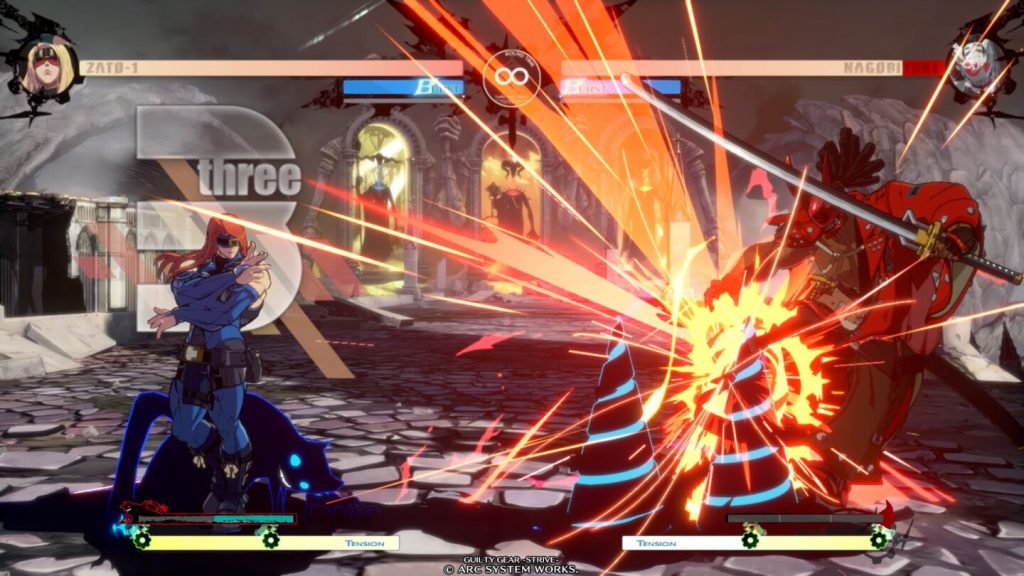
"While the new combo system does make Guilty Gear more approachable, it also imposes limitations on what characters can do that weren’t in previous games in both combos and pressure."
The gameplay, however, is the real reason you come to Guilty Gear, and it’s here that Strive has made the biggest changes. Guilty Gear has long been renowned for its incredible technical depth, but that depth can also be intimidating and a lot for new players to master. Strive attempts to fix this, to mostly positive results. By far the most important change is to the game’s combo system. Guilty Gear is a five-button fighter, with each character having access to punch, kick, slash, heavy slash, and dust attacks. In previous Guilty Gear games, lighter attacks naturally gatlinged into heavy attacks, so it was possible to chain punch into kick into slash into heavy slash into dust for a basic combo. It was a good system, allowing newbies to pull off simple combos and easily understand the combo system while allowing veterans an enormous amount of freedom when it came to combo routes.
That’s all gone in Strive. Instead, most combos now must be started with slash. There are exceptions to this rule, especially if a character has unique attacks called command moves that otherwise break that rule – Sol, for instance, can chain his kick into a forward slash and combo from there – but what that generally means is that lighter buttons like punch or kick are more about applying pressure or quicking punishing a foe’s poor decision than they are about converting stray hits into big combos.
Strive’s combos are also shorter and higher damaging than previously Guilty Gear games, so if you do land one of those bigger buttons, you’ll get more damage than you previously would, and the combo that delivers that damage will be less lengthy. Ultimately, I’m mixed on the changes to the gatling system. While it does make Guilty Gear more approachable, it also imposes limitations on what characters can do that weren’t in previous games in both combos and pressure. It does make Strive a more neutral-heavy game than previous Guilty Gear titles, and while that’s not inherently a bad thing, the old gatling system simply offered players more while still being easier to learn.
"RCs can also be used to extend combos that wouldn’t otherwise be possible or stop opponents from pressuring you. All of this has always been in Guilty Gear, but Strive makes it easier to understand by slowing down time, adding a clock to show how much time is left in the cancel, and sending out a shockwave that can extend combos automatically."
This isn’t to say Strive is a game without depth, however, because it’s not. This is still Guilty Gear, and a toned-down Guilty Gear is still one of the deepest fighters on the market. That depth mostly comes in the form of Guilty Gear’s unique Roman Cancel (hereafter RC) system, which allows you to press three attack buttons to spend 50% of your tension meter to cancel the startup of recovery animations of any attack. This has a ton of practical applications. Sol’s Gunflame, for example, a fire projectile that moves across the ground, can be RCed in such a way that the projectile still comes out but he’s no longer in the animation, allowing him to both make the move safe or follow it and continue to pressure the opponent behind the projectile.
Similarly, Potemkin can RC his Hammerfall, a strong, armored special that moves him across the screen and causes good damage, to both make it safe or set up his incredible damaging command grabs. Potemkin is a slow character that can struggle to get in on his opponents, but this allows him to get close to them safely. In addition, RCs can also be used to extend combos that wouldn’t otherwise be possible or stop opponents from pressuring you. All of this has always been in Guilty Gear, but Strive makes it easier to understand by slowing down time, adding a clock to show how much time is left in the cancel, and sending out a shockwave that can extend combos automatically. All told there are four types of RC, each color-coded for clarity and with its use.
By far the most interesting use of the system, however, is RC drifting, which is new to Strive. By dashing before inputting a RC, characters can “drift” either up, down, left, or right, allowing for combo continuations that wouldn’t even be possible during normal RCs or better neutral positioning. It’s an incredibly deep system, and it makes one of the best parts of Guilty Gear – the freedom the player has – even better.

"walls will now break if a character is hit enough, sending characters flying through them into a new part of the stage. The character sent flying takes extra damage, but they’re no longer in the corner, and the game resets to neutral. In exchange, the player who causes the wall break gains Tension more quickly and hits harder"
The game’s systems have also been consolidated. Burst – which essentially allowed characters to parry attacks at the cost of 50% meter and could crumple a character if held long enough – is completely gone, while Dead Angle Attacks, which allowed characters who are blocking to spend 50% of their meter to knock an opponent away, have become Yellow Roman Cancels. Players can still Burst out of damaging combos or use a Burst in neutral to gain meter, but the ability to sacrifice your Burst to power up an Overdrive attack is gone.
Additionally gone are Instant Kill attacks, which have been a staple of the series since the original game, which is perhaps the most glaring omission. While getting Instant Killed was never fun, it was a high-risk, high reward mechanic that required players to sacrifice their tension meter for the rest of the round to perform the attack, and it’s a shame to see such a long-time staple of the series simply disappear.
Strive isn’t all addition by subtraction, though. It does add stuff, and the most important addition is probably wall breaks. In most 2D fighters, being put in a corner means you’re going to deal with lots of pressure and be subject to corner-specific combos. While this is also true in Strive, walls will now break if a character is hit enough, sending characters flying through them into a new part of the stage. The character sent flying takes extra damage, but they’re no longer in the corner, and the game resets to neutral. In exchange, the player who causes the wall break gains Tension more quickly and hits harder, especially if they perform an Overdrive to do the wall break. I was initially skeptical of this system at first, but it works well and adds a new layer of strategy to what happens in the corner.
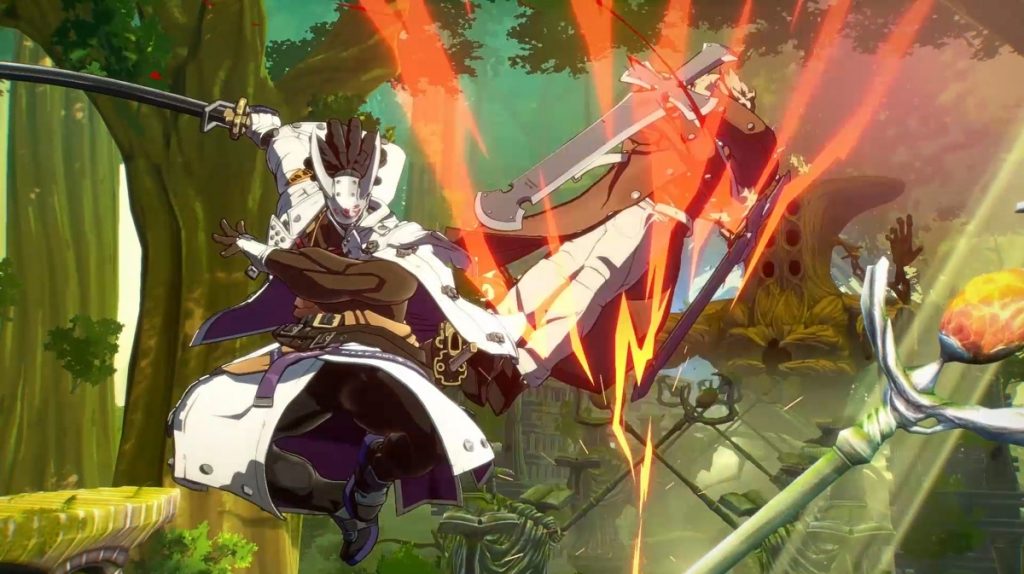
"What makes Nagoriyuki unique is that he can cancel special attacks into other specials and has a special command dash that allows him to close distances. The catch is that using his specials increases his blood meter."
So yes, Guilty Gear is still extremely complex, but the game still comes down to who you play and how you play them. Strive features a cast of 15 characters, 13 of which return to the series, and almost all of whom fill the same roles they have in the past. Sol is a pressure-heavy rushdown character who does tons of damage if he hits you, Ky’s an all-arounder who’s good at everything, Potemkin is slow but strong, Chipp is a speed demon with a low health pool, Millia is a mix-up machine whose goal is to make sure you can’t play, I-no uses musical notes and smashes people in the face with her guitar, and so on. The character designs are, as you’d expect from Guilty Gear, exceptionally wild, and no two characters play alike.
The new characters only add to the variety: Giovanna is an extremely heavy rushdown character with ungodly pressure and immense damage who can get in and stay there. The catch is that her moves are fairly stubby and her ranged options are limited, but she can wreak absolute havoc in the right hands. She also has a spirit wolf that helps her out, which is pretty cool.
Nagoriyuki, a vampire samurai, is the complete opposite. He’s exceptionally slow, can’t dash, and uses his huge sword to control a ton of space. What makes Nagoriyuki unique is that he can cancel special attacks into other specials and has a special command dash that allows him to close distances. The catch is that using his specials increases his blood meter. It can power him up, but a full blood meter puts him in a Blood Rage state that makes him slower, more powerful, and drains his life extremely quickly. The only way out of Blood Rage is to wait for it to end or use an Overdrive that is extremely unsafe when blocked. Like Giovanna, he’s a cool character, and a lot of fun to play with and against.
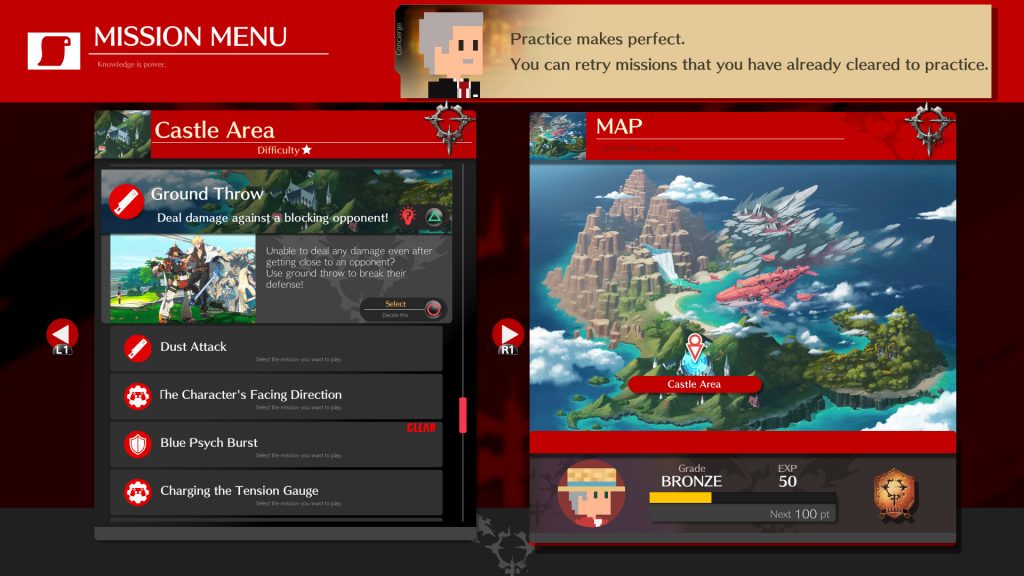
"The real training ground is the game’s absurdly detailed Mission Mode, which will walk you through everything from the basic tenets of fighting games to matchups against individual characters. These are some of the best teaching tools in fighting games."
Strive 15’s characters may not seem like a lot, but it’s impressive when you consider that they all play completely differently from one another and each of them is fun to play. Everyone, even the longest-tenured characters like Sol and Ky, has changed substantially from the series’ last outing, so there’s plenty to learn whether you’re a newbie or series veteran. Heck, I had to relearn Sol, and I’ve been playing the character for more than 15 years, so don’t feel too bad if things don’t click immediately.
No matter who you choose, Strive does a pretty good job of teaching you to play. The tutorial is pretty barebones (Arc Sys claims this is so it doesn’t intimidate people), but it will arm you with the basics if little else. The real training ground is the game’s absurdly detailed Mission Mode, which will walk you through everything from the basic tenets of fighting games to matchups against individual characters. These are some of the best teaching tools in fighting games; the only downside is that the combo challenge mode from Xrd is gone. Mission mode will teach you a few combos for each character, but it would have been nice to have more to go on. Naturally, there’s also a fully-featured training mode to practice in, as well.
The other modes are fairly standard. There’s the standard arcade and versus modes, though the former no longer has a character-specific opening and ending videos, just pre-match dialogue before the important fights. It does, however, have dynamic paths that branch slightly depending on whether you win or lose certain matches, which is a nice touch. There’s also a survival mode, pitting you against enemy after enemy, with a boss enemy with infinite tension appearing after every ten fights.
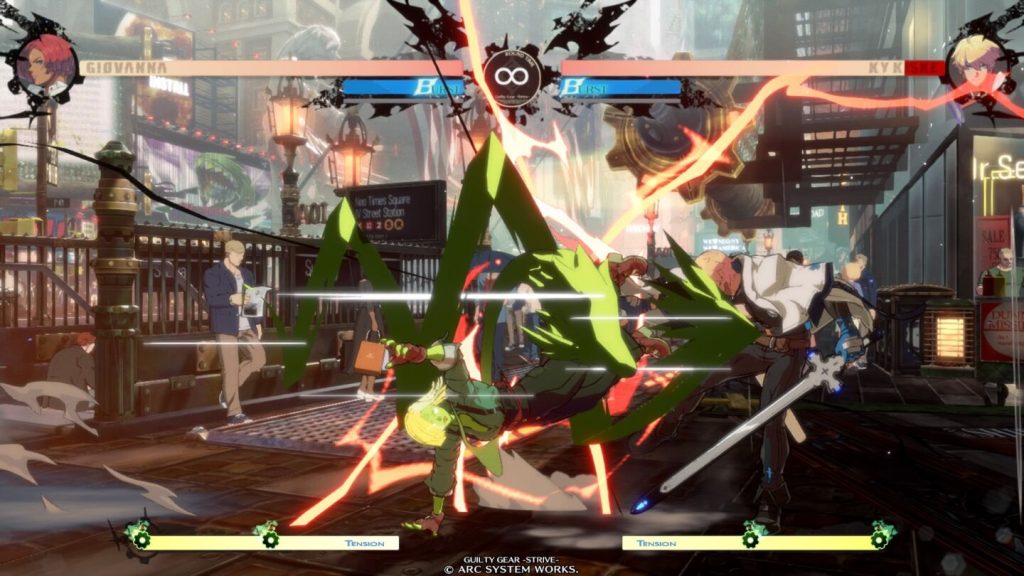
"The real draw for most, however, will be the online play, which is simultaneously Strive’s biggest success and greatest failure. The excellent part is the netcode. The problem is the game’s lobbies"
The real draw for most, however, will be the online play, which is simultaneously Strive’s biggest success and greatest failure. The excellent part is the netcode. Strive uses rollback netcode for its matches, and the improvement over Arc Sys’s older, delay-based netcode is enormous. I was able to play people both across the country and internationally nearly flawlessly, provided we could connect. I did experience occasional slowdowns, but the results are mostly pretty incredible, and I have no issues saying Strive has the best netcode of any fighting game I have ever played.
The problem is the game’s lobbies, which drop you into large, 2D rooms where your customizable avatar can challenge other players. Ranked matches place you on a level depending on how well you do. While it’s not a bad idea to stick to your assigned floor, you’re always free to challenge floors above you. It’s a neat idea, and the 8-bit aesthetic and avatar customization are genuinely well done. The issue is the lobbies themselves. Arc Sys has ironed out some of the kinks by requiring players to stand next to a machine to play other players, but it’s just not executed as well as it could be.
The lobbies can take a while to initialize and don’t always work properly. Sometimes you’ll fail to match with people, which is fine, but there are weird errors, too. A player might win two matches in the three-match set, but the player who wins last gets to stay on the machine, even if they lost more games. You can also queue while in training mode, which is great, but should you fail to match, the game will currently boot you into the core lobbies, whether you want to be there or not. Player-created rooms are better, but they still have issues with lining up for your turn to play on a machine and rematch settings. Arc Sys can do a lot to fix this stuff by ironing these issues out, but it won’t fix the lobbies’ core problem: they’re just not very good.
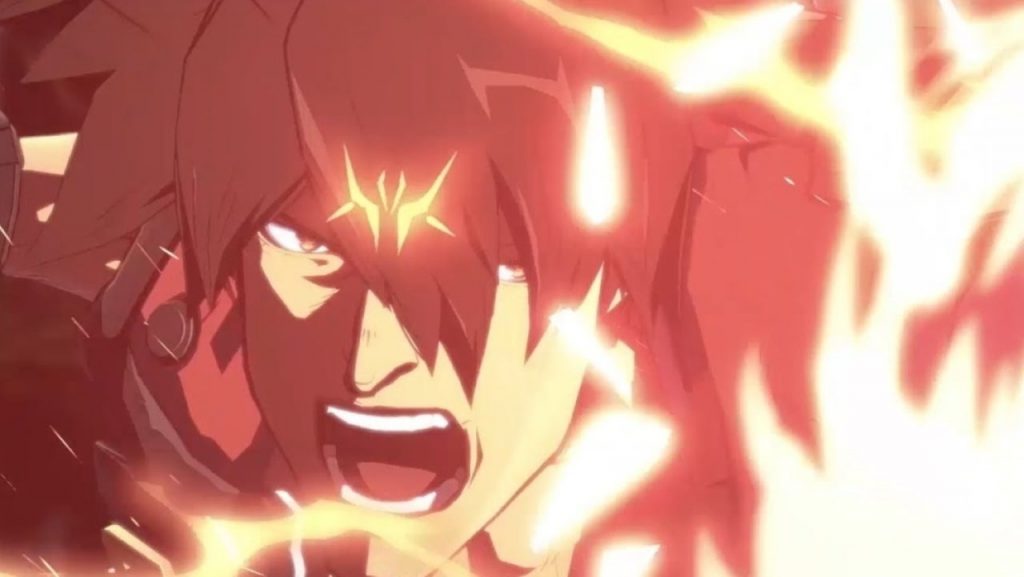
"Strive is, without question, the most beautiful fighting game I have ever played. Everything, from the character models to the backgrounds to the idle animations, is beautifully realized, and the game is incredible in motion."
Regardless of how you play, you’ll unlock World Dollars which can be spent to fish up concept art, music from past games, trailers, and so on in Collection mode. You’ll also get items to further customize your avatar. The issue here is that, unlike the Xrd games, you can only get stuff by fishing; you can’t buy items directly from the collection itself, and that can be frustrating when all you want is to buy your favorite songs or concept art for your favorite character. Worse still, you can fish up duplicate items. Duplicates take the form of fish and getting ten fish guarantees a new item, but as someone who fished quite a bit in Xrd, there comes a point when it’s just better to buy items directly than rely on luck because all you’ll end up getting is fish and random items you don’t want. Hopefully, Arc Sys will patch in the ability to do that down the line.
Fishing may be a bit of a mixed bag, but Strive’s production values aren’t. It is, without question, the most beautiful fighting game I have ever played. Everything, from the character models to the backgrounds to the idle animations, is beautifully realized, and the game is incredible in motion. The UI is a bit bland, and I could do without the enormous COUNTER notification and slowdown that appears on counter hit, but otherwise, this is a home run. The soundtrack, as you’d expect from Guilty Gear, absolutely rocks, and there’s even a fairly solid English dub, a rarity for Guilty Gear, as well, though I’d be lying if I said that I didn’t prefer the Japanese voices out of sheer familiarity.
All told, Guilty Gear Strive is an excellent fighting game that marries incredible production values, a rockin’ soundtrack, accessibility and depth, and some of the best online play in the genre to create a game that makes Guilty Gear more accessible than it’s ever been while respecting the series’ roots. It does have flaws: I don’t like all of Strive’s gameplay changes, and I wish the lobbies were better. It’ll take some time to figure out what’s possible, or how well things are balanced, but what’s clear is that Strive is a great game. When I’m not playing it, I wish I were, and when I am, it’s hard to stop. It probably doesn’t have the depth of Accent Core +R and I’ll probably never love it as much as I love Xrd, but Arc Sys has conclusively proven that they know the smell of the game, and there’s never been another time to jump in and start rockin’.
This game was reviewed on the PlayStation 5.
Strive is gorgeous. The soundtrack rocks. Plenty to unlock in collection mode. Every character is different and fun to play. Arcade mode has branching paths. Strive is easier to learn while still having tons of depth. Some of the best netcode in fighting games. The new Roman Cancel system is awesome. Survival is a lot of fun. The story is good, if silly. Wall breaks work well. The lobbies have been improved since the beta.
Story mode is not playable. The simplified gatling system is a step back. No way to unlock items without fishing. The lobbies are still kind of a mess. Small roster might turn some people off. No Instant Kills. The odd bug.










